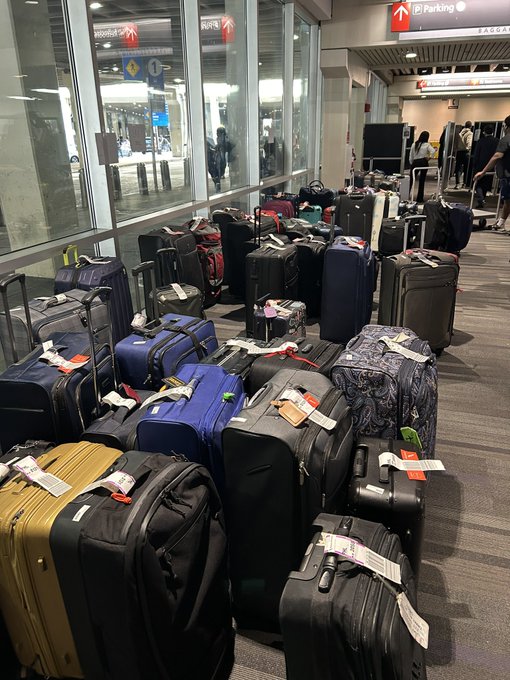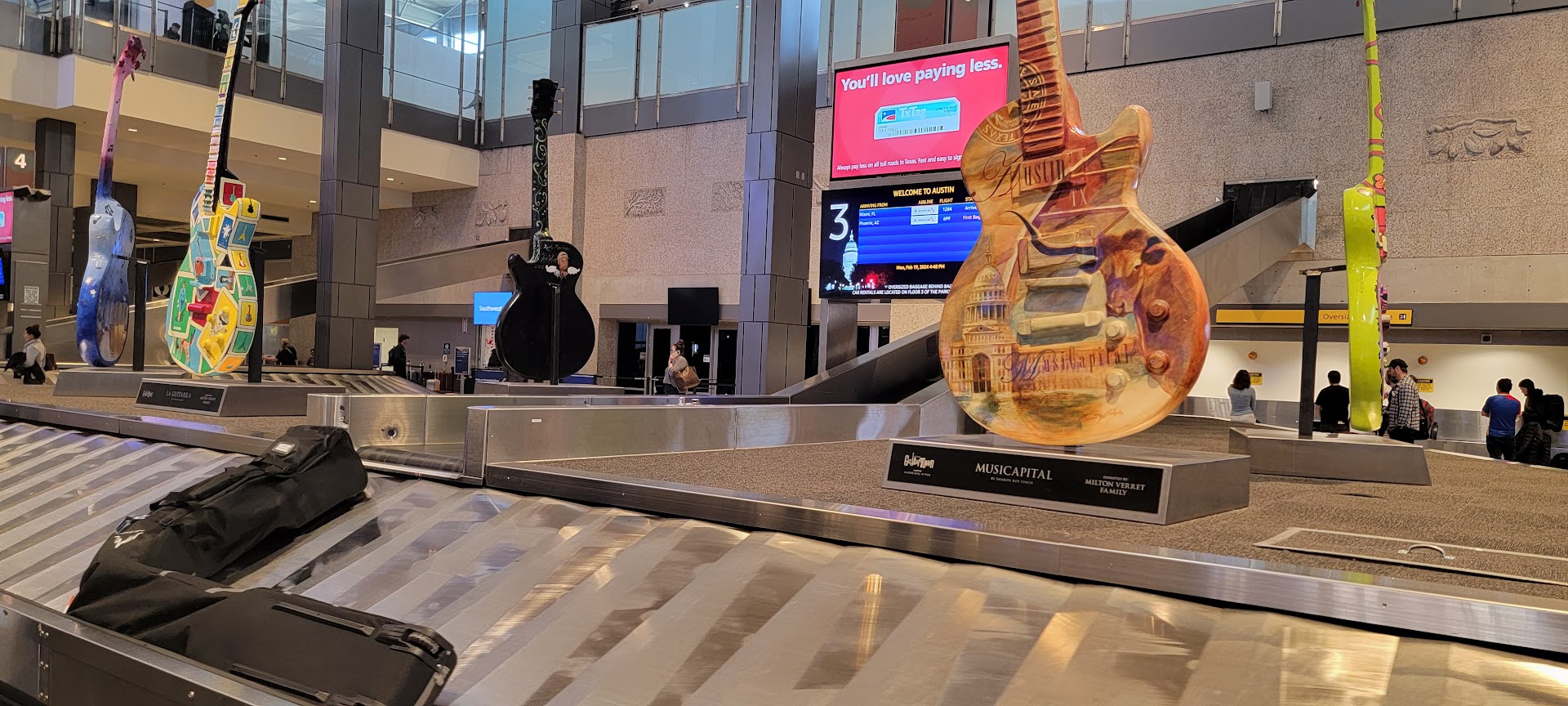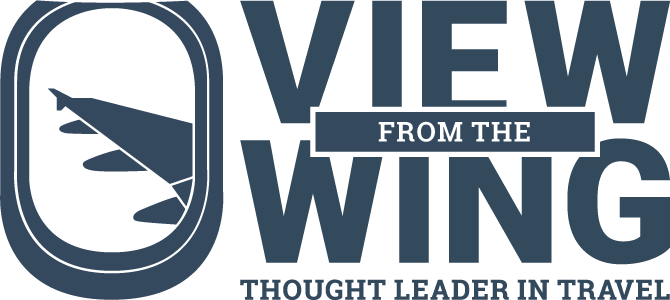Passengers have been using AirTags to track their checked bags. Initially, Lufthansa and some other airlines banned the practice arguing that the batteries were dangerous in checked luggage. Just as likely, what was happening was embarassing. For instance, an American Airlines passenger tracked down their lost luggage at a homeless camp over the summer.
An Alaska Airlines passenger watched their AirTag travel to 37 cities onboard a SkyWest regional jet. An American passenger with an AirTag i their wallet watched it travel to 35 cities. An AirTag revealed that Air Canada donated a passenger’s bag to charity.
Customers used to get frustrated, knowing where their bags were but running into a brick wall with their airline trying to get that information used. At that point I suggested that a luggage tag saying it was an AirTag was as good as having an actual AirTag, just for the deterrence value so that other passengers might not try to steal it. But actually getting the bag back was harder.

That’s changed, with airlines jumping on the bandwagon of adopting new technology deployed by Apple that lets them take in tracking data and use it to recover bags.
With the launch of iOS 18.2 three months ago, it became possible to share the location of an AirTag including with airlines. Functionality is being included in WorldTracer which is the bag tracking system used airlines and airports worldwide.
Eighteen airlines were queued to do this with Apple’s initial announcement, including Aer Lingus, Air Canada, Air New Zealand, Austrian Airlines, British Airways, Brussels Airlines, Delta Air Lines, Eurowings, Iberia, KLM Royal Dutch Airlines, Lufthansa, Qantas, Singapore Airlines, Swiss International Air Lines, Turkish Airlines, United, Virgin Atlantic, and Vueling.
Apple said that more airlines would be coming online with this. American Airlines has just done so, but hasn’t yet announced it publicly.
An American Airlines spokesperson explains to me,
We’ve introduced the ability for customers to easily and securely share the location of their AirTag or Find My network accessory directly with the airline.
Customers can generate a link through Apple’s Share Item feature available on iOS 18.2 or later and share it with American in the rare case when a bag is delayed for any trips with a segment from or to a U.S. airport. Customers just need to scan the QR code at the baggage office to start their claim and provide their information.

Month after month and year after year, American Airlines mishandles more bags – and a greater percentage of bags – than any other U.S. airline. Lost luggage costs the carrier about $60 per bag or over $50 million per year.

American’s Chief Operating Officer David Seymour told employees a few years back that it doesn’t make sense to upgrade baggage tracking technology until their airline partners have done so first. CEO Robert Isom said that some of their hubs have such backwards technology that upgrading how they track bags is too big of a challenge to undertake. This lets them ride on the rails of Apple’s technology, and lets their customers pay for the tracking.
Still, with fewer than 1% of bags mishandled (and most of those found already within 24 hours), and a $20 – $25 price per AirTag it’s not necessarily worth the investment for a casual traveler or someone who almost never checks bags or whose bags don’t contain valuable content. But if you have an AirTag, you might as well throw it into your bag and use it – now with the assistance of your airline – to help find it when it’s lost.


So the consumer is being asked to foot the bill for tracking? Geez… where’s my discount for checking the bag if I’m going to have to pay for the priveldge.
The cost of lost and delayed bags is just another item added to the cost of a ticket. It happens to all airlines so there is little incentive to improve things. I doubt things will change much at the airlines with them using AirTags to track bags. I will be pleasantly surprised if this makes a considerable difference.
Yet another reason I only do carry-on, even for a week-long trip to Asia. Not going to chance it anymore. Tired of all the games. The waiting at carousels. Nope. Never again. Unless they literally force me, I’m carry-on only. I know it’s just ‘stuff’ but still…I’m done. DONE!
Good. It was Iberia’s luggage desk in Madrid did not want to get me my lost bag that AirTag showed was only a hundred or so feet away in some luggage room – where it had been for a day- until I wore them down with polite insistence and sob stories. The tracking website stuff the airlines use when you make a lost luggage report is worthless half the time.
Always use AirTag.
I need help with a lawyer to fight JetBlue.
They lost 2 of my bags over 2 months ago and never found them.
They re refusing to pay me anything without ‘receipts’ of every item in the baggage!! (Absurd!)
My understanding of the Montreal Convention Law is that a certain amount has been given regardless of what was inside without the need to provide any proof or receipts.
For ref, I was in Mint, flying JFK-LHR.
Anyone who can help or knows a lawyer id appreciate it.
I tried contacting them, filing with DOT, got nowhere. They sticking to their claim of needing receipts.
So only Apple phone users can take advantage of this feature? The tens of millions of Android users are no able to use Air tags. I personally use Tile. Can airlines track Tile trackers too?
Most people have never heard of scottsboro, alabama for unclaimed baggage. Its an interesting retail store. This is where Lots of items from airlines across the US, for which the owner cannot be identified, are sent to be sold
They should be using SmartTags from Samsung instead. The FAs phone for tracking passengers are on Android, more of the global population uses Android, and the SmartTag can be shared through different Android manufacturers. So what gives in using Apple but a marketing campaign.
It’s not the value of the stuff in the bag that makes tracking worthwhile – it’s the inconvenience. Coming home – not a problem, outbound – problem. And some of us can’t do carry-on only. If this helps track things down, so much the better.
FWIW, I can’t tell you how many times ORD never transfers the bags, even from the check-in desk.
I agree with Kevin and was about to post the same comments. Most of the world uses Android, not Apple, products. I also think that the airlines should provide the technology and use it in their daily baggage handling operations.
@Kevin.
While I use Samsung technology, and I realize the majority of mobile devices use Android phones, the plain fact is that the Apple Air tag is vastly more accurate than the Samsung device. End of discussion, unless you choose to berate Samsung to improve their technology.
WHY can’t they hire someone to check the airline receipt with the suitcase tag before the passenger leaves the carousel area!!???
Paying a salary would be a lot less than the payouts for lost luggage and aggravation for the passenger!!! JUST DO IT!!
Julian;
To help re your lost bags contact:
If you need help with a consumer problem — any consumer problem — please drop by the Elliott Advocacy Facebook group or our Elliott Advocacy community on WhatsApp.
Re: The store in Alabama where American ships its “lost” luggage.
Two years ago I accidentally left a small personal item bag on an American Airlines plane in Miami—totally my fault. I was in a window seat and had placed it between the seat and the window. It was the first time I had flown on American in decades. My bag had a bright, undetachable luggage tag with my name, email address and mobile number, plus an Apple Air Tag attached to the handle. I also had placed my business card inside the bag. By the time I realized it was missing, I was outside of security. So I filed an online claim on American’s website for lost luggage that purports to be specifically for this purpose. I continued to monitor my bag’s journey over the next several days. Each day, I noted its location on the Apple Find My app’s map then updated my online American baggage claim with a message about where to find the bag. I included screen shots of where the bag appeared on the detailed satellite map. My bag moved around inside a room near the baggage area in MIA for several days, then disappeared and reappeared at a baggage storage area in DFW. It was there for a few days then moved to a loading dock at DFW. After a few days it moved to Alabama to a place I could cross-reference on Google Maps as being the lost luggage store. The tags were obviously still attached. I called the store but nobody ever answered. Nobody at American ever responded to my updated messages or bothered to look at my tags—not even at the luggage store in Alabama. Yes, it was my fault to leave the bag behind. But all any of them had to do was call me and I could make the Air Tag chirp so that they could find it in the storage areas. But that would require American to actually have people that gave a d@mn enough to monitor their own lost luggage website or bother to look at the obvious ID tags among their lost luggage. That was our last flight on American, and the airline is now on our “do not fly” list.
@Zod: I also use Tile. I had one which somehow fell out of my bag, and apparently stayed airside outside the terminal at MIA for an extended period until the battery died.
While Android owners may outnumber Apple, the problem is there isn’t a single tracker that everyone uses. There’s Tile, and apparently something from Samsung, and I’m pretty sure I’ve seen one or two others to choose from. I even have a single tag Amex/Marriott which might be AirTag, or Tile, or its own thing, or who knows what.
“Paying a salary would be a lot less than the payouts for lost luggage and aggravation for the passenger!!!”
Are you sure? I suspect that if paying for checkers was cheaper than the payouts, the airlines would be doing it already. Of course the airlines don’t put much value on passenger aggravation. Then again, it’s also aggravating to passengers to have to wait in line to be checked by an agent, and find their luggage receipt, before leaving the airport. And if the passenger just ripped off the luggage tag, what would the agent do?
Nice, but meaningless without knowing what if anything the airlines will do with this information. It would be nice if they’d send a human to look for the bag, but I’ve never gotten the impression that any airline had hordes of baggage-customer-service folks twiddling their thumbs looking for something to do. Overall their current model (wait for a lost bag to show up and then deal with it) might be most cost-efficient.